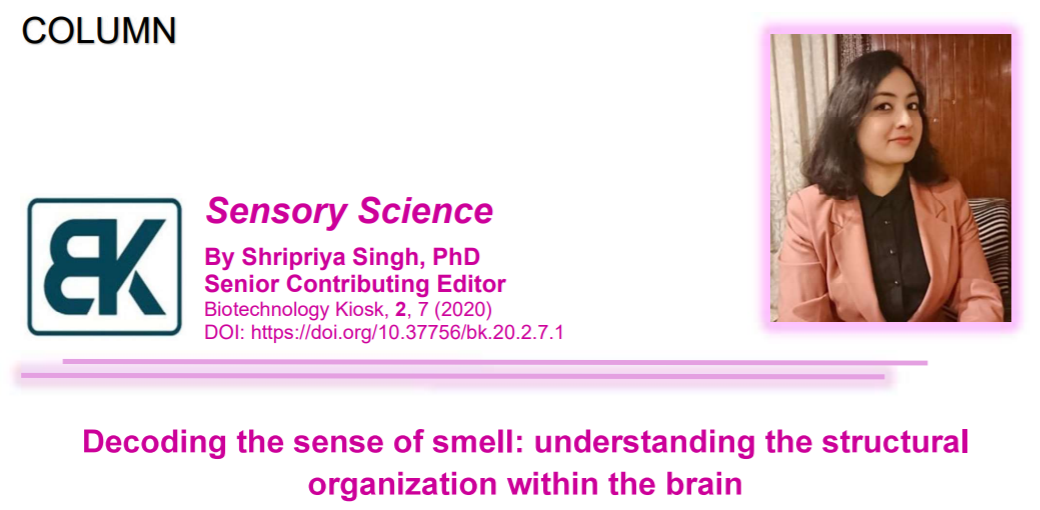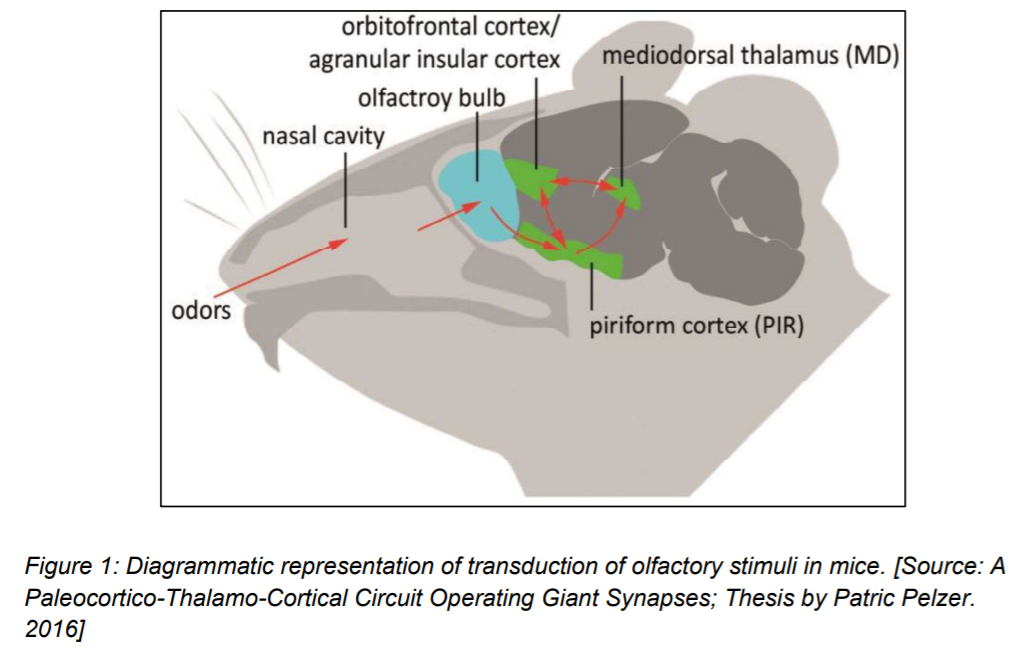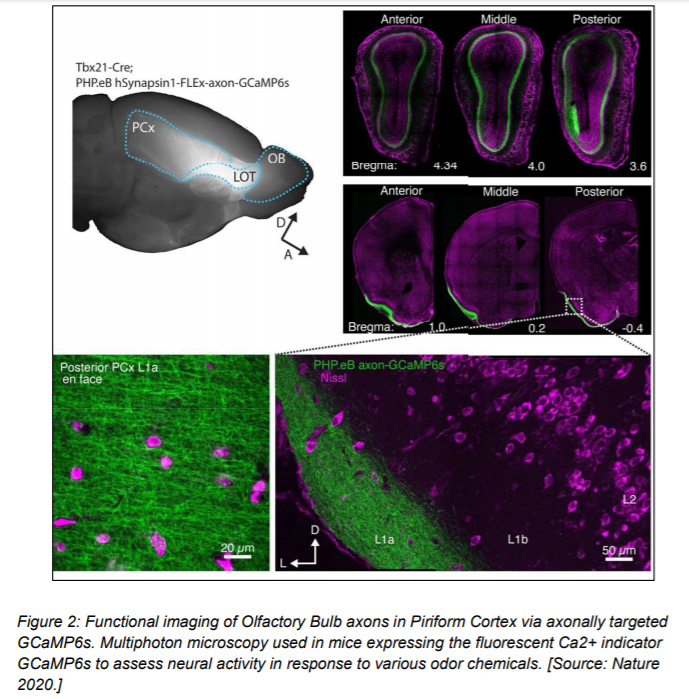Table of contents vol2 Issue 7
August 30, 2020Senolytics and Healthy Lifespan
August 30, 2020
Abstract
The olfactory sense is a potent sensory tool which helps us perceive our environment much better. However, smells despite being similar have different impacts on individuals. What makes one odor categorically different from the other and why do people have a unique and personalized experience with smell is an answer that needs to be addressed. In the present article we have discussed the research in which neuroscientists have decoded and described how the relationships between different odors are encoded in the brain. How the brain transforms information about odor chemistry into the perception of smell is a major highlight of this publication. Carefully selected odors with defined molecular structures were delivered in mice and the neural activity was analyzed. It was observed that neuronal representations of smell in the cortex reflected chemical similarities between odors, thus allowing the brain to categorize scents. The study has employed chemo informatics and multiphoton imaging in the mouse to demonstrate both the piriform cortex and its sensory inputs from the olfactory bulb represent chemical odor relationships through correlated patterns of activity. The research has given us cues in the direction of how the brain translates odor chemistry into neurochemistry and eventually perception of smell.
Keywords: smell; odor; olfactory bulb; piriform cortex; brain
Introduction
Amongst all five senses the olfactory sense is by far the most underestimated; however we cannot ignore this potent sensory tool which helps us perceive our environment much better. Hellen Keller rightly said “Smell is a potent wizard that transports you across thousands of miles and all the years you have lived.”
We as living organisms encounter various odors on a day to day basis; some odors make us tweak our noses with disgust while others make us want to whiff more. Just imagine how appealing is the smell of your favorite dish when you are hungry or how refreshing is the scent of roses when you walk through a garden. Remember the last time you complimented your special someone on how nice they smell or the time when you used aroma candles to sooth your senses. Well no matter how ignorant we are towards odors some of them will always capture our attention. Almost everyone has a preference for fragrances and what appeals to one may not smell good for the other. We often hear people talking about their signature perfumes and favorite scents, so does it simply mean people have different olfactory senses or is the perception of odors different. Well we all know that garlic will smell like garlic but it will be very different smelling from an orange. There is never a debate on this but then what makes us super sensitive towards certain odors. Fragrances and odors have the capability of evoking nostalgia, memories, romance, associations and much more. So did you ever ponder over this simple fact that why is odor such a powerful sensory stimulant? Well the answer lies in the brain…literally!
In a novel research neuroscientists have decoded and described how the relationships between different odors are encoded in the brain. The study helps us understand the underlying mechanism which enables individuals to have a common yet highly personalized experience with smell. How the brain transforms information about odor chemistry into the perception of smell is a major highlight of this publication. A team of neurobiologists from Harvard Medical School have provided us with new insights and helped us solve the mystery of scent. We shall briefly discuss the research recently published in Nature which describes for the very first time how different odors and their relationships are encoded in the region of brain responsible for processing smell, the olfactory cortex (1).
Understanding the research
Carefully selected odors with defined molecular structures were delivered in mice and the neural activity was analyzed. The team observed that neuronal representations of smell in the cortex reflected chemical similarities between odors, thus allowing the brain to categorize scents. Moreover, these representations can be rewired by sensory experiences. Animals are able to perceive the chemical nature of the environment via smell. The odor molecules are detected by the sensory neurons in the nose which relays the signal to the olfactory bulb (2). The olfactory bulb is a structure in the forebrain responsible for the initial odor processing (3). From here the information is transmitted to the piriform cortex, the main structure of the olfactory cortex, for further comprehensive processing (4). The present study has employed the use of chemoinformatics and multiphoton imaging in the mouse to demonstrate both the piriform cortex and its sensory inputs from the olfactory bulb represent chemical odor relationships through correlated patterns of activity.
Sound and light stimuli can be controlled by changing characteristics such as wavelength and frequency but it is difficult to understand how the brain translates the stimulus of odor to build a neural representation of the small molecules. Even small and subtle chemical changes such as the number of carbon or oxygen atoms can alter the molecular structure of the odor molecules and thus alter the perception of smell. The team of researchers led by Sandeep Robert Datta approached this challenge focusing on the question of how the brain identifies related but distinct odors. “The fact that we all think a lemon and lime smell similar means that their chemical makeup must somehow evoke similar or related neural representations in our brains,” Datta said.
First of all the researchers tried to quantify the odor chemicals based on properties like molecular weight, the number of atoms and electrochemical properties and then using chemoinformatics it was systematically computed how similar or different these odors are. The chemically defined odors were categorized into three sets namely a set with high diversity; one with intermediate diversity, with odors divided into related clusters; and one of low diversity, where structures varied only by incremental increases in carbon-chain length. Coming to the biological part, various combinations of odors from the different sets were then tested on mice and after being exposed to these odors multiphoton microscopic imaging was used to detect patterns of neural activity in the piriform cortex and olfactory bulb (1).Figure 1 is a schematic of transduction of olfactory stimuli in mice.

The results clearly showed similarities in odor chemistry were mirrored by similarities in neural activity. Odors that were related produced a correlated neuronal pattern both the olfactory bulb and the piriform cortex and this could be measured by overlaps in neuron activity. In contrast weakly related activity patterns were evoked by weakly related odors. The results also showed that strongly clustered patterns of neural activity were evoked in the cortex in relation to related odors as compared with the olfactory bulb. This observation remained same throughout experiments on different sets of mice. Cortical representations of odor relationships were so well-correlated that they could be used to predict the identity of a heldout odor in one mouse based on measurements made in a different mouse. Upon analysis it was discovered that patterns of neural activity were linked to a diverse array of chemical features such as electrochemical properties and molecular weight. The information gathered from the experiments is robust, reproducible and potent enough to predict cortical responses to an odor across various species. It was further observed that these neural representations were flexible. Mice were then repeatedly given a mixture of two or different odors, and over time, the corresponding neural patterns of these odors in the cortex became more strongly correlated. This process repeated even when the two odors had dissimilar chemical structures. It is the networks of neurons that selectively reshape odor relationships and thus allow the cortex to adapt to different odors. When the normal activity of these networks was blocked, the cortex encoded smells more like the olfactory bulb. “We presented two odors as if they’re from the same source and observed that the brain can rearrange itself to reflect passive olfactory experiences,” according to Data. According to him lemons and oranges smell similar partially because same species have similar genomes and therefore have similarities in perception of smell. However, different individuals will have personalized perceptions as well owing to the unique genetic makeup of every human being.

Further quoting Datta, “The plasticity of the cortex may help explain why smell is on one hand invariant between individuals, and yet customizable depending on our unique experiences.”
The visual and auditory cortices are relatively well understood in comparison to how the olfactory cortex converts information about odor chemistry into the perception of smell. Identifying how the olfactory cortex maps similar odors now provides new insights that inform efforts to understand and potentially control the sense of smell, according to the authors.
Concluding remarks
The research has clearly given us cues in the direction of how the brain translates a chemical odor molecule as an olfactory stimulus and how the neuronal networks interact to give us a comprehensive perception of smell. Any research can be best explained in the words of the original researcher and thereby we quote the authors who said “We don’t fully understand how chemistries translate to perception yet.” “There’s no computer algorithm or machine that will take a chemical structure and tell us what that chemical will smell like.” “To actually build that machine and to be able to someday create a controllable, virtual olfactory world for a person, we need to understand how the brain encodes information about smells,” “We hope our findings are a step down that path.” Thus we hope that in our near future we shall be able to clearly understand how odor chemistry translates into neurochemistry and helps us perceive our environment much better. With this we have made a small attempt to shed a neuroscientific view on the ever fascinating mystery of scent and odors. Till then we shall continue to dig our noses deep inside neuroscience till we can smell out potent and brain stimulating answers.
References
1. Pashkovski SL, et al. (2020) Structure and flexibility in cortical representations of odour space. Nature:1-6.
2. Sosulski DL, Bloom ML, Cutforth T, Axel R, & Datta SR (2011) Distinct representations of olfactory information in different cortical centres. Nature 472(7342):213-216.
3. Miyamichi K, et al. (2011) Cortical representations of olfactory input by trans-synaptic tracing. Nature 472(7342):191-196.
4. Haberly LB (2001) Parallel-distributed processing in olfactory cortex: new insights from morphological and physiological analysis of neuronal circuitry. Chemical senses 26(5):551-576.